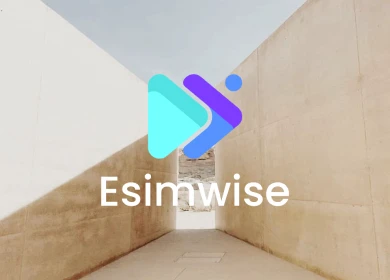Given that we live in a digital world, maintaining connections is crucial. Our mobile phones have matured into important instruments, providing communication, access to information and worldwide networking. But first, let’s pause to consider the SIM card—a little but crucial piece of technology that powers our phones.
Nano SIM cards have been the industry standard for a long time since they are dependable and well-known. But eSIM, a brand-new device, has emerged. This section will discuss eSIM vs Nano SIM, compare the two, and emphasize the differences between the two. Our ultimate goal is to determine which of these technologies is preferable to other SIM cards.
eSIM: An Overview

eSIM, short for embedded SIM, is a game-changing technology that provides a digital SIM card embedded within a device. Instead of a physical SIM card, the eSIM is integrated directly into the electronic circuitry of a device, such as a smartphone, tablet, or smartwatch. This eliminates the need for a physical SIM card and offers numerous advantages.
Nano SIM: An Overview

In contrast, the fourth generation of SIM card technology is called Nano SIM. At 12.3 x 8.8 mm, it’s the smallest SIM card on the market right now. These little wonders have completely changed the way we interact with smartphones and are now the preferred option for consumers everywhere. Modern smartphones feature a sleek design that makes it possible for nano SIMs to be seamlessly integrated despite their outstanding compactness. Nano SIM is a tiny device with a lot of capabilities for its size. However since the telecom industry is always changing, it’s vital to understand that nano SIMs could not be the last version of SIM cards as we know them.

eSIM vs Nano SIM: The Similarities
While eSIM and Nano SIM differ in terms of their physical presence, they share a number of similarities. Let’s explore the common ground:
Connectivity
Both eSIM and Nano SIM provide connectivity services, allowing users to access mobile networks and connect to the internet.
- Compatibility: Both SIM technologies are compatible with a wide range of devices, including smartphones, tablets, and wearable devices.
- Security: Both eSIM and Nano SIM offer secure authentication, ensuring that only authorized users can access the associated mobile network.
- Identification of your phone and its associated plan type.
- Simultaneous use: they can both be used simultaneously in a Dual SIM phone, giving users the flexibility of using multiple plans or numbers on the same device.
- Both are technically classified as “SIMs.”
Indeed, both are categorized as SIMs. However, a SIM card is a physical chip that requires installation or removal in your phone for your carrier’s plan. Conversely, an eSIM (embedded SIM) is integrated into your phone and digitally retrieves your carrier’s plan.
eSIM vs Nano SIM: The Differences?
Let’s now examine the characteristics that differentiate eSIM and Nano SIM:
Physical presence
- Nano SIM: This is the conventional, tangible SIM card that people are accustomed to. It is a little, rectangular card that you must place into the appropriate slot on your smartphone.
- eSIM: An eSIM is integrated into the device itself, as opposed to its physical equivalent. Since the eSIM is built right into the gadget during production, there is no need for a detachable card.
Activation Process
- Nano SIM: To activate a Nano SIM, you usually need to get a physical card from your carrier, put it in your phone, and then follow the instructions on the card to activate it.
- eSIM: It is easier to activate eSIM. Through the mobile application or by scanning the QR code supplied by the carrier, users may activate eSIM. Physical cards are no longer necessary as a result.
Convenience and flexibility
- Nano SIM: A new physical SIM card is frequently needed when switching service providers or plans. Exchanges between carriers become less convenient as a result.
- eSIM: Greater flexibility is possible due to eSIM’s embedded nature. By reprogramming the eSIM, users may swap plans or service providers more quickly without requiring a physical exchange.
Compatibility of devices
- Nano SIM: Needs a real SIM card slot, yet works with a range of devices.
- eSIM: Increasingly common on more recent gadgets, such as smartwatches, smartphones, and other Internet of Things devices. All gadgets do not, however, support eSIM technology.
International roaming
- Nano SIM: In order to avoid costly roaming costs, customers may need to swap to a local SIM card when going abroad.
- eSIM: Provides the ease of switching from a physical SIM card to a local carrier for international use.
Safeguard
- Nano SIM: User data may be impacted by physical SIM cards that are easily misplaced or stolen.
- eSIM: Since implanted eSIMs are difficult to physically remove, they can offer an additional degree of protection.
Which one is better? eSIM or Nano SIM?
In the end, the decision between eSIM and nano SIM boils down to personal preference and device usage. Let’s examine these possibilities more closely as each has advantages of its own.
Benefits of Nano SIM
The introduction of Nano SIM cards in 2012 signaled a turning point in the uptake of new technologies. Among their benefits are:
- Accessibility: Nano-SIM cards are widely utilized in more recent devices and are readily accessible, making it easier to find a suitable SIM card. (However, because scammers prey on tourists, vigilance is required.)
- Transferability: SIM cards that have been unlocked are easily taken out of one phone and put into another.
- Convenience of local number: Having a local number for calls and texts is a reason why some people choose local SIM cards.
Benefits of eSIM
When eSIM cards are included in the device, they provide unique benefits like:
- Many eSIMs: Devices are capable of storing anywhere from 15 to 20 eSIMs, which makes switching between data plans easy.
- Number retention: Dual SIM phones allow you to make and receive calls using both a physical SIM and an eSIM. eSIM data plans also allow you to make calls using a variety of apps, such as Telegram and WhatsApp.
- Regional coverage: For regular travelers, several eSIM data plans provide data usage across different nations.
- Security: eSIM data plans are safely integrated into the phone’s chip, reducing the possibility of service interruption due to a lost SIM card. This is in contrast to regular SIM cards, which may be misplaced.
FAQs
1. Can I have eSIM and Nano SIM?
It’s absolutely OK! It is possible to have both Nano SIM and eSIM on dual SIM phones. It gives you the freedom to utilize both cards at once so you may take advantage of their respective benefits. With this configuration, you may utilize the eSIM just for Internet access and select your primary SIM card for calls and texts. As a result, you may benefit from the ease of having two distinct services that operate flawlessly on your gadget.
Note: Not every Android smartphone can use eSIM services. Newer models from well-known manufacturers like Samsung, Google, and numerous more typically have it accessible. To ascertain whether your Android smartphone supports eSIM, see the manufacturer’s website or the specs on your handset.
2. How do I convert my Nano SIM to eSIM?
If your carrier allows it, you can turn a physical SIM card into an eSIM on the same iPhone. Take these actions:
Step 1: Navigate to Settings > Cellular on your iPhone.
Step 2: Select eSIM Conversion: Your carrier does not support the Convert to eSIM option if it is not visible to you. To transfer your phone number from a physical SIM card to an eSIM using eSIM Carrier Activation or by scanning a QR code, get in touch with your carrier.
Step 3: Click on Change Cellular Plan.
Step 4: Select eSIM Conversion.
Step 5: Await the activation of your eSIM. When your iPhone’s cellular plan activates, your old SIM card is deactivated.
Step 6: Take out the actual SIM card from your iPhone. Next, restart your iPhone.
Note: Not every Android smartphone can use eSIM services. Newer models from well-known manufacturers like Samsung, Google, and numerous more typically have it accessible. To ascertain whether your Android smartphone supports eSIM, see the manufacturer’s website or the specs on your handset.
Related post: How to convert a physical SIM to eSIM?
Wrap Up
To sum up, both eSIM and Nano SIM have special advantages and accommodate various customer preferences. In the end, device compatibility and personal demands will determine which option is best. You can be confident that both technologies will keep you linked to the digital world no matter which option you select.
Do you think others could use this information? Give your friends and family the information about eSIM vs Nano SIM so they can choose their connection options wisely! Let’s spread the knowledge together.
















